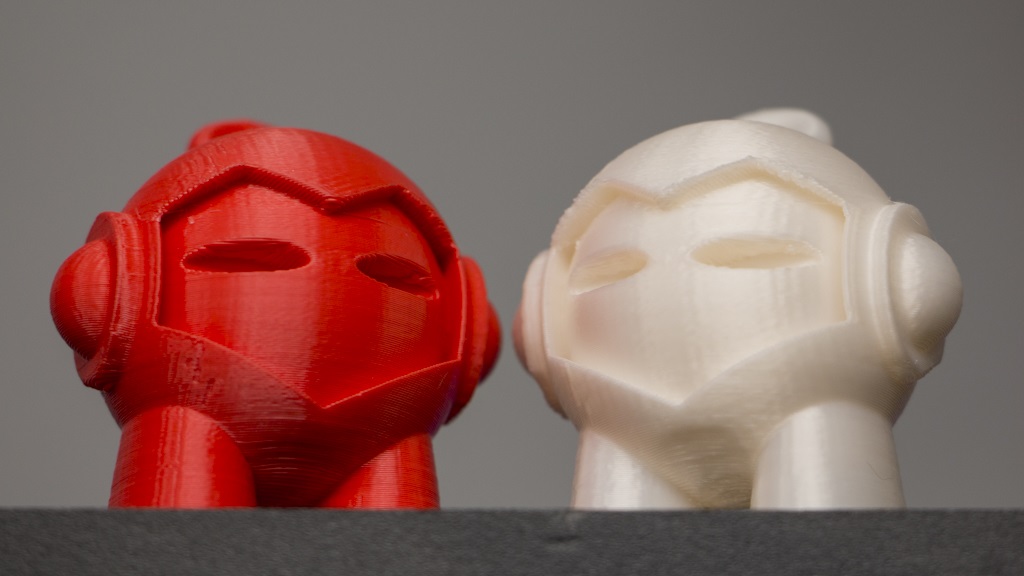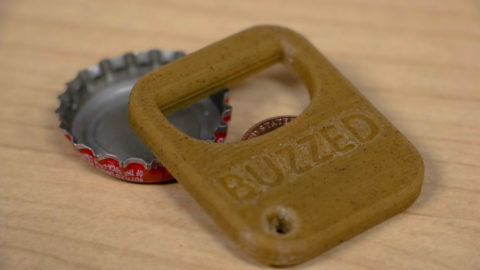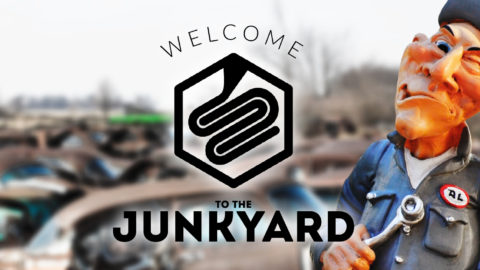Biome3D filament was released by 3Dom USA on Tuesday and we’ve been testing it ourselves, as well as having other outside testing done. We’ve been printing on nearly every machine we can, LulzBot, Makerbot, Flashforge and SeeMeCNC. Numerous test prints later, we’ve got a few observations:
- Surface finish is not shiny per se, as much as a “pearl” or sheen.
- Very tough – it can take a beating.
- Very strong layer-to-layer adhesion. In fact, if you’re printing a raft with Biome3D, you’ll have to increase the distance between your raft and your part, otherwise separating the two will be difficult.
- Biome3D is a bio-based plastic, so there is not nearly the odor that there is with ABS, it even has less of an odor than standard PLA.
- We bumped our print temperatures down at least 10 degrees from where we print with PLA when printing with Biome3D because it has good melt flow characteristics.
- It is a great plastic to work with, but also has real beneficial mechanical properties. There is a Technical Data Sheet you can download from the 3Dom USA website here.
Extra: Our in-house engineer has developed a Makerbot 5th Gen spool holder that allows you to much more easily use non-Makerbot spools. Find it on our Thingiverse page or if you can’t print it yourself but would still like one, we’ll print it for you! Find it here.
In this week’s podcast, we go into a lot more detail about Biome3D, new 3D printing filament materials and as always, have a few tips to share.








https://stromectol.science/# minocycline 50mg over the counter
I wanted to send you this very little observation so as to say thanks a lot once again on the marvelous tips you’ve contributed above. It’s wonderfully open-handed with people like you to present openly what exactly numerous people might have offered for sale as an e-book to help with making some dough on their own, specifically since you could possibly have tried it if you wanted. These good tips additionally served to provide a great way to be certain that some people have the identical passion much like my very own to grasp way more with regard to this condition. I believe there are millions of more pleasurable situations up front for folks who read through your blog post.
Yay google is my world beater assisted me to find this great internet site! .
Very interesting topic, thanks for posting. “Stranger in a strange country.” by Sophocles.
Hello my friend! I wish to say that this article is amazing, great written and include almost all significant infos. I?¦d like to see more posts like this .
Good write-up, I¦m normal visitor of one¦s site, maintain up the nice operate, and It’s going to be a regular visitor for a lengthy time.
Hey There. I discovered your weblog using msn. This is an extremely neatly written article. I will be sure to bookmark it and come back to learn more of your useful information. Thank you for the post. I will certainly return.
Hello, you used to write magnificent, but the last several posts have been kinda boringK I miss your super writings. Past few posts are just a little out of track! come on!
You actually make it seem so easy with your presentation but I find this topic to be really something which I think I would never understand. It seems too complicated and extremely broad for me. I am looking forward for your next post, I’ll try to get the hang of it!
over the counter pink eye medicine scabies treatment over the counter walmart
over the counter health and wellness products strongest over the counter painkillers
I would like to thnkx for the efforts you’ve put in writing this web site. I am hoping the same high-grade web site post from you in the upcoming also. Actually your creative writing skills has encouraged me to get my own web site now. Actually the blogging is spreading its wings rapidly. Your write up is a great example of it.
over the counter bv treatment pink eye over the counter medicine
I like what you guys are up also. Such intelligent work and reporting! Keep up the superb works guys I?¦ve incorporated you guys to my blogroll. I think it’ll improve the value of my site 🙂
over the counter pain meds nausea medicine over the counter for pregnancy
over the counter oral thrush treatment uti over the counter medication
tamiflu over the counter eczema treatment over the counter
https://over-the-counter-drug.com/# best over the counter skin tag removal
Some really wonderful posts on this website , appreciate it for contribution.
muscle relaxers over the counter best sleeping pills over the counter
Why visitors still use to read news papers when in this technological world all is existing on web?
Magnificent site. Lots of useful information here. I am sending it to a few buddies ans also sharing in delicious. And certainly, thank you to your effort!
To the fargo3dprinting.com webmaster, Thanks for the well-researched and well-written post!
There is evidently a bunch to identify about this. I suppose you made certain nice points in features also.
https://drugsoverthecounter.shop/# best over the counter cough medicine
I very delighted to find this website on bing, just what I was looking for : D as well saved to my bookmarks.
I like the helpful information you provide in your articles. I’ll bookmark your weblog and check again here regularly. I’m quite certain I’ll learn a lot of new stuff right here! Good luck for the next!
naturally like your web-site but you need to check the spelling on several of your posts. A number of them are rife with spelling issues and I find it very bothersome to tell the truth nevertheless I will definitely come back again.
Hello there, I found your website by means of Google while looking for a comparable topic, your web site got here up, it appears to be like good. I have bookmarked it in my google bookmarks.
Excellent web site. Lots of helpful information here. I am sending it to a few pals ans also sharing in delicious. And certainly, thank you to your effort!
Hello my friend! I wish to say that this post is awesome, nice written and include approximately all vital infos. I would like to see more posts like this.
Heya i am for the first time here. I came across this board and I to find It truly helpful & it helped me out a lot. I am hoping to present something again and aid others such as you helped me.
Wow, incredible blog format! How long have you been running a blog for? you made running a blog glance easy. The full look of your web site is excellent, as well as the content material!
I genuinely enjoy looking through on this web site, it holds excellent blog posts.
Heya i am for the first time here. I found this board and I in finding It really helpful & it helped me out a lot. I hope to give something back and aid others such as you aided me.
I like the valuable info you provide to your articles. I will bookmark your blog and test once more right here regularly. I’m fairly sure I’ll learn many new stuff proper right here! Best of luck for the following!
I’m really impressed together with your writing abilities and also with the layout for your blog. Is that this a paid topic or did you customize it yourself? Either way stay up the nice high quality writing, it is uncommon to see a great weblog like this one these days..
I like the helpful information you provide in your articles. I’ll bookmark your blog and check again here regularly. I am quite certain I will learn lots of new stuff right here! Best of luck for the next!
demais este conteúdo. Gostei bastante. Aproveitem e vejam este conteúdo. informações, novidades e muito mais. Não deixem de acessar para descobrir mais. Obrigado a todos e até mais. 🙂
You are my aspiration, I possess few web logs and very sporadically run out from to post .
Those are yours alright! . We at least need to get these people stealing images to start blogging! They probably just did a image search and grabbed them. They look good though!
Keep functioning ,great job!
I am not sure where you’re getting your info, but good topic. I needs to spend some time learning more or understanding more. Thanks for fantastic info I was looking for this information for my mission.
Wow! Thank you! I continuously needed to write on my site something like that. Can I implement a portion of your post to my site?
Wonderful beat ! I wish to apprentice while you amend your web site, how can i subscribe for a blog website? The account helped me a acceptable deal. I had been a little bit acquainted of this your broadcast offered bright clear idea
Very wonderful information can be found on website.
I happen to be writing to let you know what a superb discovery my princess obtained viewing your site. She mastered too many things, not to mention how it is like to possess an excellent giving character to make many others very easily fully grasp several complicated things. You actually surpassed visitors’ expected results. I appreciate you for coming up with these important, healthy, edifying and also fun tips about your topic to Gloria.
Have you ever considered about including a little bit more than just your articles? I mean, what you say is valuable and all. Nevertheless imagine if you added some great photos or videos to give your posts more, “pop”! Your content is excellent but with images and clips, this site could undeniably be one of the greatest in its field. Fantastic blog!
Pretty section of content. I just stumbled upon your weblog and in accession capital to assert that I acquire in fact enjoyed account your blog posts. Any way I will be subscribing to your feeds and even I achievement you access consistently quickly.
I really appreciate this post. I have been looking all over for this! Thank goodness I found it on Bing. You’ve made my day! Thank you again
Some really prize blog posts on this internet site, saved to my bookmarks.
Hello, Neat post. There is a problem along with your site in internet explorer, may test this?K IE nonetheless is the marketplace leader and a huge section of other folks will omit your wonderful writing due to this problem.
I’ve been absent for some time, but now I remember why I used to love this web site. Thanks , I¦ll try and check back more often. How frequently you update your website?
I keep listening to the reports talk about receiving free online grant applications so I have been looking around for the most excellent site to get one. Could you tell me please, where could i get some?
Lovely site! I am loving it!! Will be back later to read some more. I am bookmarking your feeds also.
Thank you, I have recently been looking for info about this subject for ages and yours is the best I have discovered till now. But, what about the conclusion? Are you sure about the source?
The root of your writing whilst appearing reasonable in the beginning, did not really sit very well with me after some time. Someplace throughout the sentences you actually managed to make me a believer but only for a while. I however have a problem with your leaps in logic and you would do well to help fill in all those breaks. If you actually can accomplish that, I would undoubtedly end up being amazed.
Enjoyed reading this, very good stuff, appreciate it. “Love begets love, love knows no rules, this is the same for all.” by Virgil.
Heya i am for the first time here. I found this board and I find It really helpful & it helped me out a lot. I am hoping to present something back and aid others such as you aided me.
My brother suggested I might like this web site. He was totally right. This post truly made my day. You can not imagine simply how much time I had spent for this information! Thanks!
I’m not that much of a online reader to be honest but your blogs really nice, keep it up! I’ll go ahead and bookmark your site to come back in the future. Many thanks
What’s Going down i’m new to this, I stumbled upon this I have discovered It positively useful and it has aided me out loads. I’m hoping to contribute & assist different users like its helped me. Good job.
Howdy, i read your blog occasionally and i own a similar one and i was just curious if you get a lot of spam remarks? If so how do you reduce it, any plugin or anything you can recommend? I get so much lately it’s driving me mad so any support is very much appreciated.
Merely wanna input on few general things, The website design and style is perfect, the subject material is rattling great. “Drop the question what tomorrow may bring, and count as profit every day that fate allows you.” by Horace.
This is the proper weblog for anybody who needs to seek out out about this topic. You understand a lot its virtually laborious to argue with you (not that I truly would need…HaHa). You positively put a brand new spin on a subject thats been written about for years. Great stuff, simply nice!
Hi, i think that i saw you visited my weblog so i came to “return the favor”.I’m trying to find things to improve my website!I suppose its ok to use some of your ideas!!
I think this is one of the most important info for me. And i’m glad reading your article. But should remark on some general things, The web site style is wonderful, the articles is really nice : D. Good job, cheers
Hello, i think that i saw you visited my website so i came to “return the favor”.I am trying to find things to enhance my site!I suppose its ok to use some of your ideas!!
Good – I should definitely pronounce, impressed with your website. I had no trouble navigating through all the tabs and related info ended up being truly simple to do to access. I recently found what I hoped for before you know it in the least. Reasonably unusual. Is likely to appreciate it for those who add forums or anything, web site theme . a tones way for your client to communicate. Excellent task.
That is the best blog for anyone who desires to find out about this topic. You notice so much its virtually hard to argue with you (not that I really would want…HaHa). You positively put a brand new spin on a topic thats been written about for years. Great stuff, simply great!
very nice post, i certainly love this web site, keep on it
I beloved up to you will obtain performed proper here. The caricature is tasteful, your authored material stylish. nevertheless, you command get got an impatience over that you wish be delivering the following. in poor health definitely come more previously again since precisely the same nearly very regularly inside of case you shield this hike.
very nice put up, i definitely love this web site, carry on it
I like your writing style genuinely enjoying this internet site.
Deference to website author, some superb entropy.
Heya i’m for the primary time here. I found this board and I to find It really useful & it helped me out a lot. I hope to offer one thing back and help others such as you helped me.
Thanks for the marvelous posting! I actually enjoyed reading it, you could be a great author.I will make certain to bookmark your blog and will often come back down the road. I want to encourage you to definitely continue your great work, have a nice holiday weekend!
Im not positive the place you’re getting your information, but great topic. I must spend a while finding out more or figuring out more. Thanks for excellent info I used to be on the lookout for this information for my mission.
This is a wonderful article, Given so much info in it, These type of articles keeps the users interest in the website, and keep on sharing more … good luck.
Everything is very open and very clear explanation of issues. was truly information. Your website is very useful. Thanks for sharing.
It¦s really a great and helpful piece of info. I¦m satisfied that you simply shared this helpful info with us. Please stay us informed like this. Thanks for sharing.
Sweet website , super layout, really clean and apply pleasant.
You are a very clever individual!
I am only commenting to let you know of the fine experience my cousin’s girl obtained going through yuor web blog. She came to find lots of pieces, including what it is like to have a very effective giving nature to have the rest with ease fully grasp chosen multifaceted topics. You undoubtedly did more than our expected results. Thanks for showing these useful, trusted, revealing and as well as cool guidance on the topic to Kate.
Your style is so unique compared to many other people. Thank you for publishing when you have the opportunity,Guess I will just make this bookmarked.2
Hi, i believe that i noticed you visited my website so i got here to “go back the favor”.I’m trying to in finding issues to improve my website!I assume its ok to make use of some of your ideas!!
Hello. excellent job. I did not anticipate this. This is a impressive story. Thanks!
you could have a great blog here! would you like to make some invite posts on my blog?
I am incessantly thought about this, thankyou for posting.
You really make it seem so easy with your presentation but I find this matter to be really something which I think I would never understand. It seems too complicated and extremely broad for me. I’m looking forward for your next post, I will try to get the hang of it!
I’ve been surfing online more than three hours today, yet I never found any interesting article like yours. It’s pretty worth enough for me. Personally, if all web owners and bloggers made good content as you did, the net will be much more useful than ever before.
Hey very cool website!! Man .. Beautiful .. Amazing .. I’ll bookmark your site and take the feeds also…I’m happy to find a lot of useful info here in the post, we need work out more techniques in this regard, thanks for sharing. . . . . .
Great work! This is the type of info that should be shared around the internet. Shame on the search engines for not positioning this post higher! Come on over and visit my web site . Thanks =)
F*ckin¦ remarkable things here. I am very satisfied to look your article. Thanks a lot and i’m looking ahead to contact you. Will you kindly drop me a mail?
Wow, fantastic weblog structure! How lengthy have you ever been running a blog for? you made running a blog look easy. The entire glance of your website is fantastic, let alone the content!
Spot on with this write-up, I actually assume this website wants way more consideration. I’ll most likely be again to read far more, thanks for that info.
Very well written story. It will be useful to everyone who employess it, including yours truly :). Keep doing what you are doing – i will definitely read more posts.
Hello would you mind stating which blog platform you’re working with? I’m planning to start my own blog soon but I’m having a hard time deciding between BlogEngine/Wordpress/B2evolution and Drupal. The reason I ask is because your layout seems different then most blogs and I’m looking for something completely unique. P.S Sorry for being off-topic but I had to ask!
I saw a lot of website but I think this one holds something special in it in it
Hi, I think your site might be having browser compatibility issues. When I look at your website in Safari, it looks fine but when opening in Internet Explorer, it has some overlapping. I just wanted to give you a quick heads up! Other then that, fantastic blog!
I love your blog.. very nice colors & theme. Did you make this website yourself or did you hire someone to do it for you? Plz respond as I’m looking to construct my own blog and would like to know where u got this from. kudos
Hi there very nice blog!! Man .. Excellent .. Wonderful .. I’ll bookmark your site and take the feeds also…I’m satisfied to find numerous helpful information right here in the post, we’d like work out extra strategies in this regard, thanks for sharing. . . . . .
I discovered your blog site on google and verify just a few of your early posts. Continue to maintain up the excellent operate. I simply further up your RSS feed to my MSN Information Reader. In search of forward to reading more from you in a while!…
Hello I am so delighted I found your webpage, I really found you by mistake, while I was browsing on Bing for something else, Anyhow I am here now and would just like to say thanks a lot for a marvelous post and a all round entertaining blog (I also love the theme/design), I don’t have time to read it all at the moment but I have saved it and also added in your RSS feeds, so when I have time I will be back to read a great deal more, Please do keep up the great work.
Heya! I just wanted to ask if you ever have any problems with hackers? My last blog (wordpress) was hacked and I ended up losing several weeks of hard work due to no back up. Do you have any methods to prevent hackers?
Does your site have a contact page? I’m having problems locating it but, I’d like to shoot you an e-mail. I’ve got some recommendations for your blog you might be interested in hearing. Either way, great site and I look forward to seeing it expand over time.
Good write-up, I’m regular visitor of one’s web site, maintain up the nice operate, and It’s going to be a regular visitor for a long time.
Of course, what a fantastic blog and revealing posts, I definitely will bookmark your site.Best Regards!
Unquestionably believe that which you stated. Your favorite reason appeared to be on the internet the simplest thing to be aware of. I say to you, I certainly get irked while people consider worries that they plainly do not know about. You managed to hit the nail upon the top and defined out the whole thing without having side effect , people can take a signal. Will likely be back to get more. Thanks
Some truly interesting points you have written.Helped me a lot, just what I was looking for : D.
Thank you for the good writeup. It in fact was a amusement account it. Look advanced to more added agreeable from you! However, how can we communicate?
Saved as a favorite, I really like your blog!
I conceive this website holds some real fantastic information for everyone : D.
This is the right blog for anyone who wants to find out about this topic. You realize so much its almost hard to argue with you (not that I actually would want…HaHa). You definitely put a new spin on a topic thats been written about for years. Great stuff, just great!
I went over this website and I think you have a lot of wonderful info , saved to my bookmarks (:.
What’s Happening i am new to this, I stumbled upon this I have found It absolutely useful and it has helped me out loads. I hope to contribute & aid other users like its aided me. Great job.
Thank you so much for giving everyone such a special opportunity to read in detail from this website. It’s usually so useful plus stuffed with fun for me and my office colleagues to visit your blog more than 3 times in 7 days to find out the fresh guides you have. And definitely, I’m so actually astounded considering the incredible points you give. Selected two areas on this page are unquestionably the most suitable we have all had.
Who watched blackpinks new albume and MV its amazing
I really appreciate this post. I have been looking everywhere for this! Thank goodness I found it on Bing. You’ve made my day! Thx again
Hello my friend! I want to say that this article is amazing, nice written and include approximately all significant infos. I would like to see more posts like this.
I got good info from your blog
It is in point of fact a great and useful piece of information. I¦m glad that you simply shared this helpful info with us. Please keep us up to date like this. Thank you for sharing.
Very good information can be found on blog.
[b][url=https://body-rub.manhattan-massage.com]upscale body rub nyc[/url][/b]
Good day .
Top craftsmen at the present time worth its weight in gold , in this regard prices for Thai massage in Manhattan Beach rather expensive . In our SPA you can find out all the beauty useful procedure practically for nothing .
Relaxing massage of the whole body positive affects all without exception systems and organs our body:
o Muscles and Joints – improved mobility , you will recover faster after a visual load, elimination of lactic acid and recovery from exercise
o Skin – activates flow blood, occurs saturation oxygen
o Vessels – getting rid of edema , normalizing the cardiovascular system and relieving anemia
o Nervous system – improve mood , headaches go away , improve health, relief from headaches and spasms , relieve nervous tension and improve well-being .
Swedish massage more important in case losing weight and getting rid of c ellulite.
The Luxurious Classic massage in Ditmars waiting customer here.
o Impressive variety options massage techniques
o Sessions Hardware – vibration full body massage from 1 hour
Offer all of you , visit the site and learn all methods of massage personally.